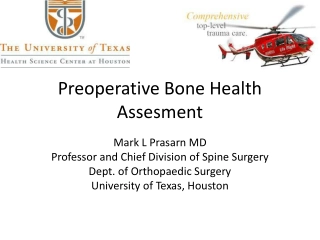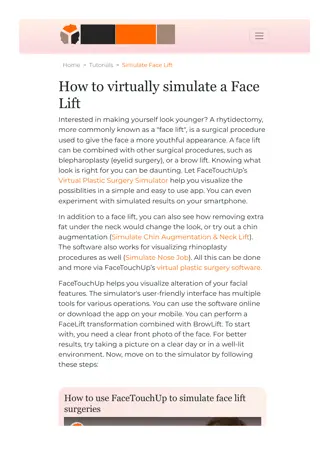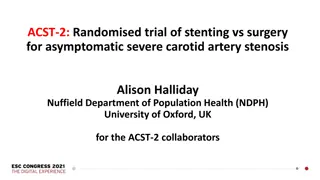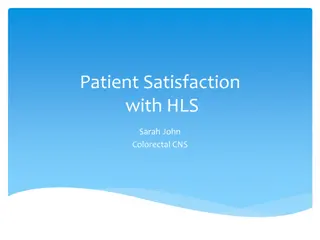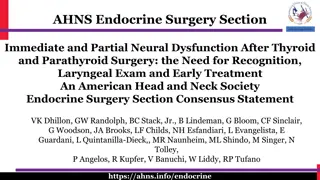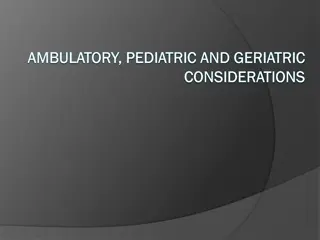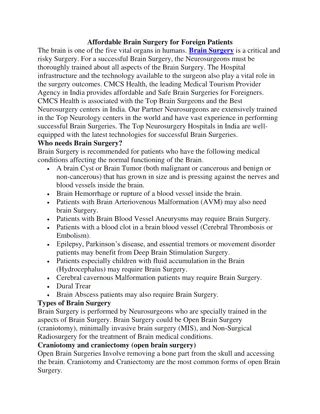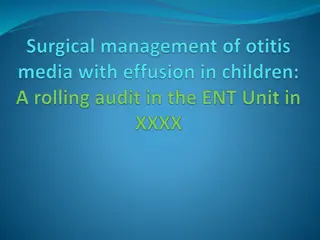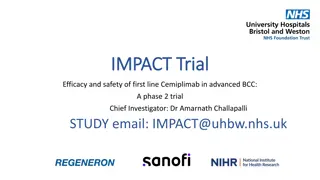Surgery Considerations for Von Willebrand Disease Patients
This presentation covers surgical considerations for patients with Von Willebrand Disease, including case studies, treatment options, and therapy basics. It explores factors like bleeding history, baseline VWF levels, and the impact of surgery type on treatment decisions.
Download Presentation

Please find below an Image/Link to download the presentation.
The content on the website is provided AS IS for your information and personal use only. It may not be sold, licensed, or shared on other websites without obtaining consent from the author.If you encounter any issues during the download, it is possible that the publisher has removed the file from their server.
You are allowed to download the files provided on this website for personal or commercial use, subject to the condition that they are used lawfully. All files are the property of their respective owners.
The content on the website is provided AS IS for your information and personal use only. It may not be sold, licensed, or shared on other websites without obtaining consent from the author.
E N D
Presentation Transcript
SURGERY IN PATIENTS WITH VON WILLEBRAND DISEASE Ana Boban, MD, PhD Michael Mazzeffi, MD MPH MSc June 2021 2
CONFLICT OF INTEREST AND FUNDING This HEMOSTASIS CONNECT programme is supported through independent educational grant from Takeda. The programme is therefore independent, the content is not influenced by the supporters and is under the sole responsibility of the experts. Please note: The views expressed within this presentation are the personal opinions of the authors. They do not necessarily represent the views of the author s academic institution, or the rest of the HEMOSTASIS CONNECT group. Dr. Ana Boban has received financial support/sponsorship for research support, consultation, or speaker fees from the following companies: Alexion, Novartis, Takeda, Octapharma, Pfizer, Sobi, Roche, Bayer, Novo Nordisk, CSL Behring Dr. Michael Mazzeffi has no conflicts of interest to declare 3
CONSIDERATIONS FOR SURGICAL PATIENTS WITH VON WILLEBRAND DISEASE 4
CASE 1 42-year-old obese man presents for two-level lumbar laminectomy surgery History Type 2a von Willebrand disease Had some excessive bleeding with a prior dental extraction Preoperative laboratory values INR 1.1 VWF:RCo 25 IU/dL, VWF:Ag 60 IU/dL Haemoglobin 12 g/dL Platelet count 180 x 109/L He is seen in the preoperative clinic 1 week before surgery for appropriate operative planning INR, international normalised ratio; VWF:Ag, von Willebrand factor antigen; VWF:RCo, von Willebrand ristocetin cofactor 5
CONSIDERATIONS FOR TREATMENT OF SURGICAL PATIENTS WITH VON WILLEBRAND DISEASE Is it major or minor surgery? Are critical structures at risk if a bleeding complication occurs? (e.g. spine surgery, neurosurgery, cardiac surgery) Type of von Willebrand disease Prior bleeding history Baseline VWF:Ag level, VWF:Rco and FVIII:C FVIII:C, factor VIII coagulant activity; VWF:Ag, von Willebrand factor antigen; VWF:RCo, von Willebrand ristocetin cofactor 6
THERAPY BASICS Treatment options impact of disease type Type 1 Types 2 and 3 Can often be treated with desmopressin Typically treated with VWF concentrates Target levels and monitoring Maintain FVIII and VWF activity levels of 0.5 IU/mL for 3 days after surgery Plasma-derived VWF +/- FVIII or recombinant VWF 40-80 IU/kg VWFa Desmopressin should be tested for response before needed The specific target levels should be individualised, based on the type of disease, bleeding phenotype and type of the procedure Antifibrinolytics Added to desmopressin or VWF concentrates Alone in minimally invasive procedures aIn case of pure VWF concentrate, consider additional FVIII concentrate with the initial infusion Connell NT, et al. Blood Adv. 2021;5:301-325 FVIII, factor VIII; VWF, von Willebrand factor; VWF:Ag, von Willebrand factor antigen; VWF:RCo, von Willebrand ristocetin cofactor 7
SURGICAL AND ANAESTHETIC CONSIDERATIONS FOR PREGNANT PATIENTS WITH VON WILLEBRAND DISEASE 8
CASE 2 22-year-old woman presenting to the gynaecology department at the 32ndweek of first pregnancy History von Willebrand disease type 1 Bleeding symptoms include severe menstrual bleeding and bleeding following trauma in early childhood Treated with tranexamic acid and VWF-FVIII concentrate Laboratory values Haemoglobin 12.2 g/dL Platelet count 187 x 109/L WBC 7.1 PT 1.22 sec APTT 30.9 sec Fibrinogen 4.0 g/L VWF:RCo 17.2 IU/dL VWF:Ag 18.0 IU/dL The pregnancy has been uneventful so far She has questions about type of birth and epidural anaesthesia APTT, activated partial thromboplastin time; FVIII, factor VIII; PT, prothrombin time; VWF, von Willebrand factor; VWF Ag, von Willebrand factor antigen; VWF:RCo, von Willebrand ristocetin cofactor; WBC, white blood cell count 9
PREGNANCY AND DELIVERY IN WOMEN WITH VON WILLEBRAND DISEASE Pregnancy is well-tolerated in women with VWD VWF levels during pregnancy Many women reach normal levels of VWF and FVIII at term, but the increase may not be as significant in severe VWD Delivery Most women do not need additional treatment (vaginal or caesarean) Thrombocytopenia may worsen in type 2b VWD The centre for delivery should be able to monitor VWF and FVIII levels and administer VWF concentrates Postpartum Anaesthesia consultation should be obtained prior to the onset of labour VWF levels Risk of serious bleeding Recommended VWF target range for neuraxial anaesthesia is 50-150 IU/dL VWF levels VWF levels start to decline hours after delivery, reaching basal values within 1 week Time Postpartum bleeding is increased in women with VWD, shortly after delivery and up to 3 weeks postpartum Regular follow-up and monitoring throughout pregnancy Plan delivery ahead! VWF and FVIII should be maintained >50 IU/dL for 3-5 days postpartum FVIII, factor VIII; VWD, von Willebrand disease; VWF, von Willebrand factor 10
KEY TAKE-AWAYS Planning Advance planning is very important in patients with von Willebrand disease requiring surgery and/or anaesthesia Multidisciplinary approach A collaborative, multidisciplinary approach with open lines of communication before, during and after surgery or delivery between surgeon, gynaecologist, anaesthesiologist and haematologist is crucial to mitigate the risk and prevent excessive bleeding Adequate haemostasis support Patients with von Willebrand disease should have surgical procedures performed in a facility where adequate haemostasis support is available, including access to a coagulation laboratory 11
RECOMMENDED FURTHER READING 2021 guidelines on the management of VWD, by ASH, ISTH, NHF, WFH Includes guidance on surgery, delivery and the post partum period ASH ISTH NHF WFH 2021 guidelines on the management of von Willebrand disease Connell NT, et al. ASH ISTH NHF WFH 2021 guidelines on the management of von Willebrand disease. Blood Adv. 2021;5:301-325 Contemporary review on management of surgical patients with VWD Perioperative management of patients with von Willebrand disease O'Donnell JS, Lavin M. Perioperative management of patients with von Willebrand disease. Hematology Am Soc Hematol Educ Program. 2019;2019(1):604-9 Recent retrospective analysis of anaesthesia around delivery in patients with VWD Most patients (N=71, 106 deliveries) received neuraxial anaesthesia for labour and delivery; no adverse events Anesthetic Management of von Willebrand Disease in Pregnancy: A Retrospective Analysis of a Large Case Series. Anesthetic Management of von Willebrand Disease in Pregnancy: A Retrospective Analysis of a Large Case Series. Reale SC, et al. Anesthetic Management of von Willebrand Disease in Pregnancy: A Retrospective Analysis of a Large Case Series. Anesth Analg. Online ahead of print 29 April 2021 Comprehensive overview by the ACOG on VWD in women Signs and symptoms; evaluation, screening and diagnosis; and specific considerations for gynaecology, obstetrics and adolescent care Committee Opinion No.580: von Willebrand disease in women. Committee Opinion No.580: von Willebrand disease in women. Committee on Adolescent Health Care; Committee on Gynecologic Practice. Committee Opinion No.580: von Willebrand disease in women. Obstet Gynecol. 2013;122:1368-73 Review on VWD and pregnancy Factor VIII, VWF levels and bleeding during pregnancy, labour and postpartum; epidural/spinal anaesthesia; complications with type 2 VWD; neonatal complications; miscarriage; genetic counselling and treatment von Willebrand disease and pregnancy. Kujovich JL. von Willebrand disease and pregnancy. J Thromb Haemost. 2005;3:246-53 ACOG, American College of Obstetricians and Gynecologists; ASH, American Society of Hematology; iSTH, International Society on Thrombosis and Haemostasis; NHF, National Hemophilia Foundation; VWD, von Willebrand disease; WFH, World Federation of Hemophilia 12
Hemostasis CONNECT Bodenackerstrasse 17 4103 Bottmingen SWITZERLAND Dr. Froukje Sosef MD +31 6 2324 3636 froukje.sosef@cor2ed.com Dr. Antoine Lacombe Pharm D, MBA +41 79 529 42 79 antoine.lacombe@cor2ed.com Connect on LinkedIn @Hemostasis CONNECT Watch on Vimeo @Hemostasis CONNECT Visit us at hemostasisconnect.info Follow us on Twitter @HemeConnect Heading to the heart of Independent Medical Education Since 2012


